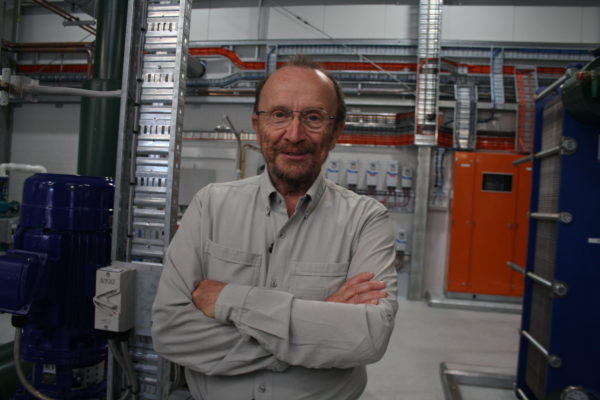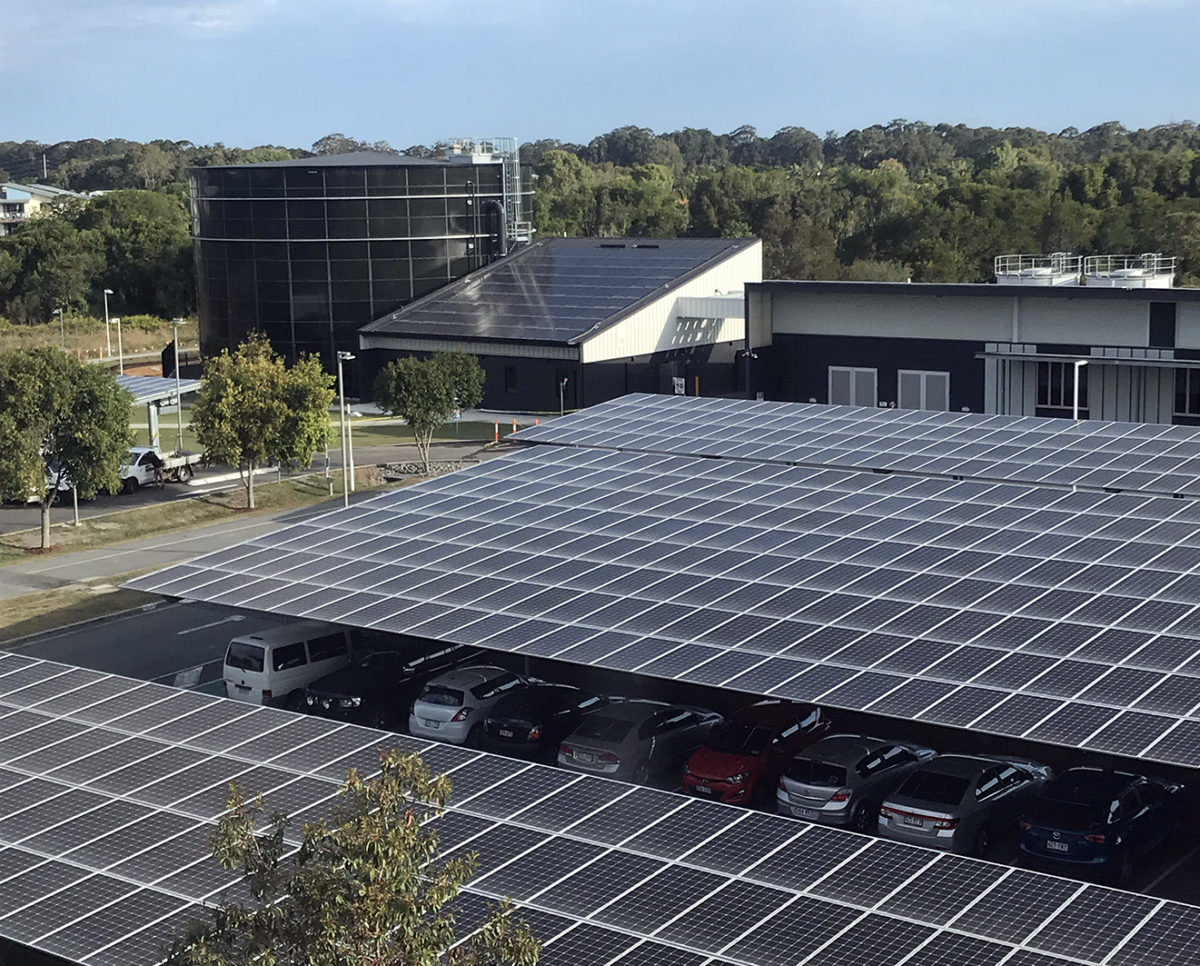Dennis Frost is cooling the planet, one university campus at a time, with the help of Veolia’s energy-as-a-service innovation, 2.1 MWac of rooftop solar PV and a battery that stores energy as 4.5-megalitres of chilled water.
The demonstration and education project at Queensland’s University of the Sunshine Coast (USC), where Frost is Manager of Energy and Infrastructure, is the start of an ambitious rollout of clean-energy developments that is planned to include renewably produced hydrogen, and a campus of the future at Moreton Bay.
USC’s solar-fed thermal-battery installation, officially switched on last Thursday in the presence of state Minister for Natural Resources, Mines and Energy, Dr Anthony Lynham, is the first of its kind in Australia and will save the university around $100 million in electricity bills over 25 years of operation, but with longevity likely to extend beyond the calculated period.
About half of the solar system’s output goes into chilling the tank water which provides on-campus air-conditioning — representing 40% of the 15,000-student university’s energy consumption — while remaining energy is carefully distributed according to algorithms formulated to deliver the best bang per electron.
“We very heavily monitor the production of solar, and either use it to run the chillers to top up our thermal battery, or self consume on site, or export to the grid, depending on our needs and the time of year,” says Frost, who is described by Veolia Australia’s Regional Energy Services Manager, Andrew Darr, as “a visionary”.
Meter first, to make informed decisions later
When Frost arrived at USC about seven years ago, he tells pv magazine, “It became obvious to me that we were flying quite blind in relation to energy use on site.” He immediately instituted systematic metering and measurement of electricity consumption in every building and process, including water recycling, lighting, computer processes and air-conditioning, and undertook measures to improve efficiency in each area.
“Then I set about convincing the university that we need to lead in sustainability, and we put together a carbon management plan, to be carbon neutral by 2025.”
About four years ago, after multinational Veolia had acquired Dalkia which then provided energy services to the University, “USC was looking to undertake a step change in energy consumption for the site,” says Darr, and the collaboration between Veolia and USC began.
According to both parties, the partnership has succeeded due to an alignment of values around sustainability, and says, Frost, because of trust and transparency between them. “The Queensland Government has a procurement guideline called a Market-Led Proposal, which enabled me to deal with Veolia as a single supplier, so we were able to open up the books,” he says.
“The model has been designed and continually redesigned during the process for the best outcomes, as opposed to the best profitability of the party building it.”
Veolia designed, constructed and runs the $12 million system, on behalf of USC. “There are further O&M costs, but it’s all built in to the final energy price that they pay,” Darr tells pv magazine. “The university is paying two tariffs — one for thermal chilled water and another for electricity.” After 10 years the system will be wholly paid off and owned by USC, and the energy it generates will become free.
The renewable-energy-fed thermal-energy-storage model, now proven, is transferable to other universities, technical and further education (TAFE) institutes and organisations with good rooftop or ground-mounted solar resource, and high air-conditioning, heating (the tank could as easily store heated water) or even refrigeration needs, says Darr.
“If you want to use it for refrigeration, you could store the energy in an ice bank,” he says.

Image: University of the Sunshine Coast
Tank arrays give drivers respite from the sun
At USC’s main Sippy Downs campus, car parking shaded from the searing Queensland solar resource is a bonus gained from the installation of 6,000 solar panels on rooftops and “carport” structures throughout the site.
Provision has been made for 80 electric-vehicle charging bays within the car-park infrastructure — current EV penetration means that only four have so far been energised.
Part of the engineering of the system required that high-density solar generation be situated close to the two transformers driving the four chillers near the tank — hence the positioning of the two car-park arrays, says Darr.
But the big thing, says Frost was “not only the technical and engineering solution, but to create a living lab so that we can teach the next generation that the planet can be saved.
“Yes, there is a technical solution, and a financial solution, but the most important solution is embedding this in the teaching and learning on the academic side of the university.”
Angela Cooney, Sustainable Solutions Manager at Veolia Australia, attests to enthusiastic student involvement in the project, not only of engineering and science students, but of business students: “I have an entrepreneurial group at the moment doing a project with me around the communication of the sustainability goals of the University. There are a lot of positives,” she says.
Not coasting, but riding the renewable wave
Frost has wasted no time in capitalising on the goodwill and positive response to the phase-one USC initiative, which will save 92,000 tonnes of CO2 emissions over 25 years (equivalent to the output of 525 average Australian homes during the same time frame).
Dovetailing with Queensland Government ambitions to become a hotbed of clean hydrogen innovation, USC has placed a grant application for funds to use water captured on the university’s main campus at Sippy Downs, and power from a further 4.5 MW of installed solar PV, to sustainably generate and store energy in the form of hydrogen, potentially using it to run some university vehicles and channelling excess heat generated by the process into heating the campus swimming pool.
“That should take care of the next 58% of the footprint from this site,” says Frost, and will demonstrate to students further applications of renewable energy and a way forward to carbon abatement on a larger scale.
The University’s plans for a second campus at Moreton Bay open a clean slate for approaches to renewable-energy generation. USC and Veolia are seeking an ARENA grant to properly investigate and model an ambitious and innovative micro grid. Watch this hot solar space.
This content is protected by copyright and may not be reused. If you want to cooperate with us and would like to reuse some of our content, please contact: editors@pv-magazine.com.









2 comments
By submitting this form you agree to pv magazine using your data for the purposes of publishing your comment.
Your personal data will only be disclosed or otherwise transmitted to third parties for the purposes of spam filtering or if this is necessary for technical maintenance of the website. Any other transfer to third parties will not take place unless this is justified on the basis of applicable data protection regulations or if pv magazine is legally obliged to do so.
You may revoke this consent at any time with effect for the future, in which case your personal data will be deleted immediately. Otherwise, your data will be deleted if pv magazine has processed your request or the purpose of data storage is fulfilled.
Further information on data privacy can be found in our Data Protection Policy.